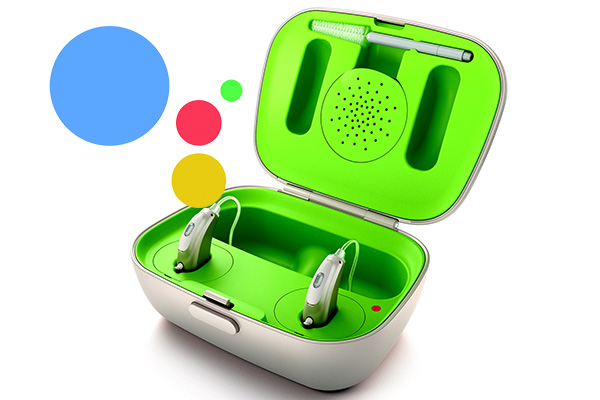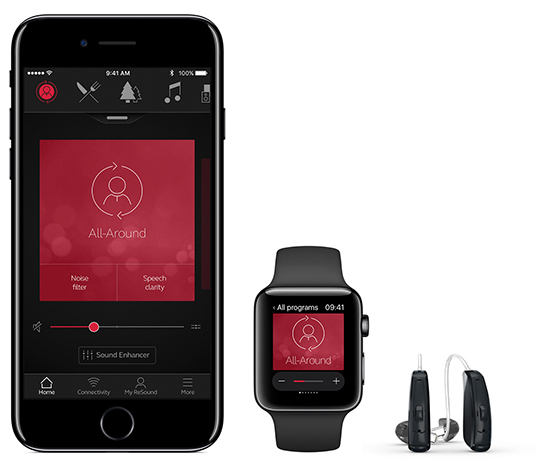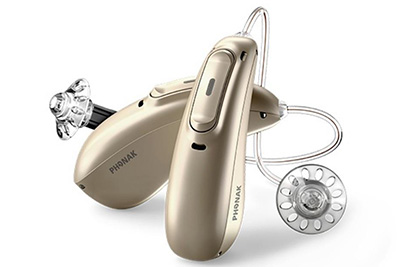Android 10 Offers a Google Assistant Onramp for Hearing Aids

Google released an update to its mobile operating system this week, titled Android 10, which comes packed with a number of exciting new accessibility features. Android 10 will initially be limited to Google’s Pixel line of phones, but Google states that it will be made available for other handset manufacturers later this year.
Included in these features is a long awaited, Bluetooth low-energy (BLE) protocol that supports streaming to hearing aids from Android devices. With this update, Google has ushered in the era of made-for-Android hearing aids, and notably, a new set of homes to host Google Assistant.
Hearing Aids and Bluetooth Connectivity

In 2014, Danish hearing aid manufacturer GN Resound introduced the first set of Bluetooth hearing aids, called the Linx. Resound worked closely with Apple to develop the unique Bluetooth protocol to allow for Bluetooth connectivity between iPhones and hearing aids. This 2.4 GHz BLE protocol would later be dubbed “made-for-iPhone” (MFi) and be adopted by all six of the major hearing aid manufacturers as each introduced its own line of MFi hearing aids in the subsequent years.
The protocol, however, was limited to Apple devices, so hearing aid wearers who owned Android smartphones were left with no viable options to directly stream audio and calls to their hearing aids. For the years following the introduction of MFi hearing aids, Android continued to primarily use the Bluetooth Classic protocol to pair devices via Bluetooth, which was too power-hungry of a protocol and not viable for the battery life of the hearing aid to support streaming.
The BLE Workaround
 In 2018, Swiss hearing aid manufacturer, Sonova, looked to solve the Android handset owner’s dilemma by manufacturing a chipset, SWORD, that supports five Bluetooth protocols and had been engineered specifically to circumvent the power constraints of Bluetooth Classic. Sonova’s brands, Phonak and Unitron, each now offer hearing aids containing the SWORD chip that are able to pair seamlessly with any smartphone.
In 2018, Swiss hearing aid manufacturer, Sonova, looked to solve the Android handset owner’s dilemma by manufacturing a chipset, SWORD, that supports five Bluetooth protocols and had been engineered specifically to circumvent the power constraints of Bluetooth Classic. Sonova’s brands, Phonak and Unitron, each now offer hearing aids containing the SWORD chip that are able to pair seamlessly with any smartphone.
While hearing aid wearers now have the option to pair their Android devices to Sonova’s hearing aids, Sonova only represents a portion of the total hearing aids sold. This is why the introduction of Android 10 is such a significant milestone for hearing aid and smartphone compatibility, as it’s an open source protocol that any third party OEM can adopt. While GN Resound will once again lead the way and be the first hearing aid manufacturer to offer a device that’s compatible with Android smartphones using Android 10, it surely won’t be alone for long, just as it wasn’t the only manufacturer to offer MFi hearing aids.
Google Assistant Now Viable on Hearing Aids
With the advent of open-source BLE in Android we’re nearing an era where hearing aid Bluetooth compatibility is truly ubiquitous. Made-for-Android hearing aids are meaningful beyond the context of streaming, as they offer a viable home for Google Assistant too.
Currently, the assistant would be housed in the smartphone, but any Android handset supporting Android 10, would offer the option to enable, “Hey Google,” invocation. This means that in order to communicate with Google Assistant in ones’ hearing aid, the user would need to keep her phone close enough to where the phone’s microphones pick up the wake word.
As we saw at Google I/O developer conference this year, Google is set to roll out its Google Assistant 2.0 in the near future. This update will move some Assistant features from the cloud to the device, which will result in a decrease in latency. The speedier Google Assistant will represent a compelling option for Android hearing aid wearers to migrate an increasing number of tasks from the incumbent method of tap, touch and swipe to speech.
It should be noted that aside from the small subset of hearing aid users wearing Sonova’s devices with its SWORD chip in conjunction with Android phone, virtually no hearing aid wearers today are yet to experience this type of functionality although Starkey’s Livio AI Thrive Assistant quasi-uses Google Assistant. Most hearing aid wearers to this point have been limited to Siri, which is considerably less robust and capable that Google Assistant in many regards, such as the way Google leverages its knowledge graph. The disparity between Siri and Google Assistant may become even more pronounced as Google rolls out its upgraded assistant in the near future.
A More Compelling Hearing Aid
A few months ago, I wrote a post about how voice assistant-enabled hearing aids have the potential to empower our aging population and increase adoption. In that post, I mentioned the fact that only about 25-30% of adults aged 70 and older who could benefit from wearing hearing aids have ever used them. This is a problem considering that our population is getting older as the baby boomers continue crossing into retirement and the co-morbidities linked to hearing loss continue to rise.
It would appear that our aging population is finding a lot of value from voice assistants. A recent article published in MIT Technology Review, highlights the success that nonprofits like Front Porch is having with introducing voice technology to its residents by installing smart speakers into its residents’ homes. Also mentioned is Project Zilver, an initiative headed by Jeroen Vonk and Martin Lens Fitzgerald that is having similar success to Front Porch in the Netherlands. From a market adoption perspective, research conducted by NPR and Edison Research indicated that adults aged 55+ represent one of the largest age cohorts adopting smart speakers among the first adopters and early mainstream.
While price and vanity tend to be the most often cited culprits responsible for the low adoption of hearing aids, it might also be that the value proposition of the devices is not strong enough, especially in light of the high price and negative stigma. One way to strengthen the value proposition might be to convert the value our aging population is finding in their smart speakers, into their hearing aids. In addition to Android-streaming, Google Assistant-enabled hearing aids offer a new dynamic to the hearing aid value proposition. This might ultimately compel some folks to go and seek treatment for their hearing loss on the basis that hearing aids can pair to their Android smartphone and serve as an access point to Google Assistant.
Empowering Our Aging Population with Voice Assistant Enabled Hearing Aids
Apple and Spotify Earnings Point to Growth in the Aural Attention Economy








